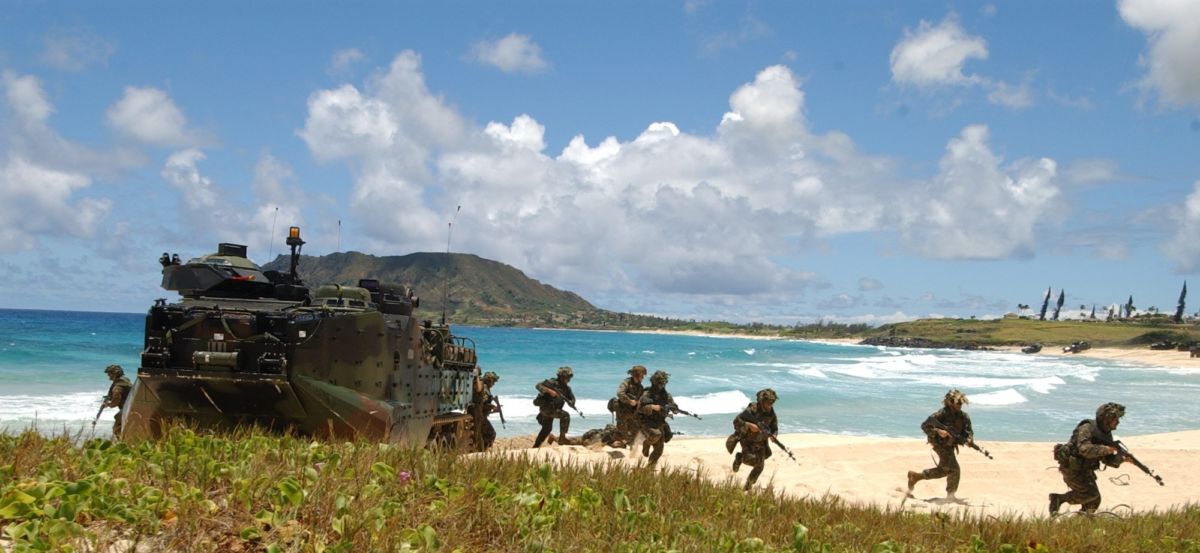Honest, paywall-free news is rare. Please support our boldly independent journalism with a donation of any size.
The North Korean missile scare in Hawaii a year ago was alarming. But that fear has abated. Once again the greatest perceived threat to the island of Oahu comes from our own US military.
A massive complex of 20 US military storage tanks is buried in a bluff called Red Hill that overlooks Honolulu’s primary drinking water supply, 100 feet below.
The walls on the 75-year-old jet fuel tanks are now so thin that the edge of a dime is thicker. Each of the underground tanks holds 12.5 million gallons of jet fuel; 225,000,000 gallons in total.
In 2014, 27,000 gallons of jet fuel leaked through a weak spot on a tank that had been repaired with a welded patch. The welding gave way and the fuel entered the the water supply.
Drinking water is currently safe to drink, but traces of petroleum chemicals are being detected in the groundwater near the tanks.
Leaks have been going on for years. Studies have documented them since 1947. The continued corrosion of the tank liners constantly risks a catastrophic fuel release.
Concerned citizens on the island have for decades been trying to get the US Navy to remove the tanks. The military’s position is that the fuel tanks are of strategic importance to US national security and are being maintained as well as 75-year old tanks can be.
Formidable Opponent
The military is a formidable political opponent here.
Military expenditures in Hawaii — direct and indirect combined — generate $14.7 billion into Hawaii’s economy, creating more than 102,000 jobs. Military procurement contracts amount to about $2.3 billion annually, making it a prime source of contracting opportunities for hundreds of Hawaii’s small businesses, including significant military construction projects.
The state of Hawaii is one of the most militarized states in the nation. Oahu is one of the most militarized islands. It has seven major US military bases, including Pearl Harbor Naval and Hickam Air Force, headquarters of the US Pacific Air Forces.

The island has a total of 36,620 military personnel spread over the Army, Navy, Marines, Air Force and Coast Guard. When the 64,000 military family members and military contractors are added to the active duty military, the military-industrial complex on Oahu numbers about 100,000, 10 percent of Oahu’s total population of 988,000.
The US has acknowledged the medical problems the contamination of the drinking supply caused at another community; the huge US Marine Base at Camp Lejeune, NC, and Marine Corps Air Station in New River, North Carolina.
From 1953 through 1987, tens of thousands of Marines and their families were exposed to two on-base water wells that were contaminated with trichloroethylene (TCE), perchloroethylene (PCE), benzene, vinyl chloride among other compounds from on-base leaking storage tanks and an off-base dry cleaner.
At long last, the Veterans Administration has acknowledged the dangerous situation on the bases in North Carolina that was ignored for decades. The VA has declared that a large number of diseases are caused by the chemicals and that military and family members who have contracted these diseases and who are still living will be compensated.

On the other side of the country from North Carolina, the Navy has already closed down one complex of underground jet fuel storage tanks at Point Loma, California, which had 54 storage tanks. The riveted seams on the underground tanks began leaking as they aged. When 1.5 million gallons of fuel spilled from the site in 2006, the US Navy was decided to replace the tanks.
Question of When, Not If
For us on Oahu, the bottom line is that when — not if — the massive jet fuel storage tanks leak into the aquifer of Honolulu, city, state and federal officials must be held accountable. The public has given them plenty of warning of their concerns.
In Flint, Mich., officials also knew that the drinking water was contaminated. They didn’t do anything to stop the community from using it. Remarkably, no Flint official has gone to jail yet, but the community is demanding accountability for malfeasance in office — which would be the same in Honolulu when disaster strikes on the jet fuel storage tanks.
I will make this personal.
I am 72 years old and served 29 years in the US military. I retired 20 years ago. The 20 jet fuel storage tanks are 75 years old and have served each of those 75 years and are still serving.
At 72, I have had the normal number of aches and pains including a hip replacement that didn’t turn out the best and skin cancer surgery that left skin grafts and patches on my face, head and leg.
At 75, the 20-story jet fuel storage tanks also have had aches and pains as well as their skin getting thinner and thinner due to seven decades of corrosion. Patching of the thin skin of the Red Hill jet fuel tanks didn’t turn out so well either, with the welding on one of the patches giving way in 2014.
Those of us in our 70s, whether we are fuel tanks or humans, know all about leaks — it’s a hazard of age.
I retired from the US Army after 29 years of service. After 75 years of service, it’s time to retire the leaking Red Hill Storage tanks — and protect our precious water supply.
Media that fights fascism
Truthout is funded almost entirely by readers — that’s why we can speak truth to power and cut against the mainstream narrative. But independent journalists at Truthout face mounting political repression under Trump.
We rely on your support to survive McCarthyist censorship. Please make a tax-deductible one-time or monthly donation.
